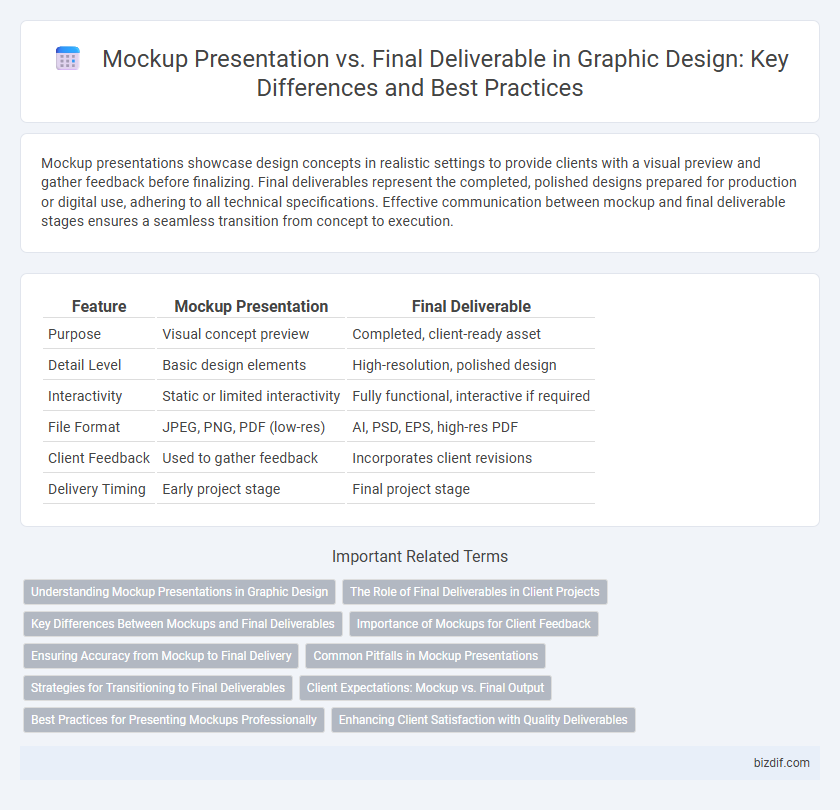Mockup presentations showcase design concepts in realistic settings to provide clients with a visual preview and gather feedback before finalizing. Final deliverables represent the completed, polished designs prepared for production or digital use, adhering to all technical specifications. Effective communication between mockup and final deliverable stages ensures a seamless transition from concept to execution.
Table of Comparison
| Feature | Mockup Presentation | Final Deliverable |
|---|---|---|
| Purpose | Visual concept preview | Completed, client-ready asset |
| Detail Level | Basic design elements | High-resolution, polished design |
| Interactivity | Static or limited interactivity | Fully functional, interactive if required |
| File Format | JPEG, PNG, PDF (low-res) | AI, PSD, EPS, high-res PDF |
| Client Feedback | Used to gather feedback | Incorporates client revisions |
| Delivery Timing | Early project stage | Final project stage |
Understanding Mockup Presentations in Graphic Design
Mockup presentations in graphic design serve as realistic visual prototypes that showcase how the final design will appear across various mediums, helping clients visualize the project outcome before production. These presentations emphasize layout, color schemes, and branding elements, allowing for feedback and refinements to ensure alignment with client expectations. Unlike final deliverables, mockups are not production-ready files but essential tools for iterative design validation and approval processes.
The Role of Final Deliverables in Client Projects
Final deliverables in graphic design projects serve as the polished, production-ready files that clients use for printing or digital deployment, ensuring brand consistency and quality. Unlike mockup presentations, which visualize concepts and receive client feedback, final deliverables include all specifications like CMYK color profiles, vector formats, and proper bleed settings tailored to the intended medium. These finalized assets are crucial for maintaining project integrity, meeting client expectations, and facilitating a seamless transition to marketing or manufacturing stages.
Key Differences Between Mockups and Final Deliverables
Mockup presentations showcase visual concepts with placeholder content and flexible design elements, allowing clients to review layout, colors, and overall aesthetic before finalization. Final deliverables consist of polished, production-ready files with precise specifications, optimized for printing or digital use, ensuring accurate color profiles, resolution, and file formats. Key differences include the purpose of mockups as a preview tool versus final files designed for implementation and distribution.
Importance of Mockups for Client Feedback
Mockup presentations play a crucial role in graphic design by providing clients with a realistic visual representation of the final product, enabling clearer understanding and more precise feedback. This iterative process helps identify design adjustments early, reducing costly revisions during the final deliverable stage. Effective mockups enhance client satisfaction and streamline project workflows, ensuring the final deliverable aligns closely with client expectations.
Ensuring Accuracy from Mockup to Final Delivery
Ensuring accuracy from mockup presentation to final deliverable requires meticulous attention to detail, including color fidelity, typography consistency, and layout precision. Utilizing high-resolution mockups and collaborating closely with clients during the review stage minimizes discrepancies and aligns expectations. Final deliverables must undergo rigorous quality checks to confirm that all design elements accurately reflect the approved mockup specifications.
Common Pitfalls in Mockup Presentations
Common pitfalls in mockup presentations include unrealistic expectations due to low-fidelity visuals that fail to represent actual user experience. Designers often overlook responsive behavior and interactivity, causing clients to misinterpret the final product's functionality. Inadequate communication of design limitations and missing contextual information can lead to client dissatisfaction and scope creep during the final deliverable phase.
Strategies for Transitioning to Final Deliverables
Effective strategies for transitioning from mockup presentation to final deliverables include thorough client feedback integration and iterative design refinement to ensure alignment with project goals. Utilizing version control tools and establishing clear communication channels streamlines revisions and maintains design consistency. Prioritizing file organization, standardized formatting, and preparing assets for multiple platforms boosts efficiency and quality in delivering final graphic design outputs.
Client Expectations: Mockup vs. Final Output
Client expectations often differ between mockup presentations and final deliverables in graphic design, with mockups serving as visual prototypes that outline concept and layout, while final deliverables provide polished, production-ready files adhering to technical specifications. Mockups allow clients to visualize the design direction and request adjustments prior to finalization, ensuring alignment on aesthetics and functionality. Final deliverables must meet resolution, color mode, and format standards suitable for printing or digital use, fulfilling the practical requirements beyond the conceptual stage shown in mockups.
Best Practices for Presenting Mockups Professionally
Use high-quality, realistic mockups that accurately represent the final design to convey professionalism and client confidence. Ensure all elements are aligned, colors are consistent, and typography is clear to showcase the design intent effectively. Include context-specific backgrounds or devices to help clients visualize the design in real-world scenarios, enhancing comprehension and approval rates.
Enhancing Client Satisfaction with Quality Deliverables
Mockup presentations provide clients with a clear visual preview, enabling early feedback and alignment with their vision. Final deliverables showcase polished, high-resolution designs optimized for print or digital use, ensuring professional standards and usability. Delivering both mockups and refined final files enhances client satisfaction by reducing revisions and ensuring expectations are met accurately.
Mockup presentation vs Final deliverable Infographic

 bizdif.com
bizdif.com